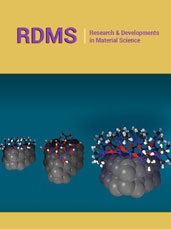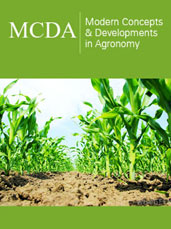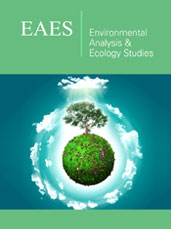- Submissions

Full Text
COJ Technical & Scientific Research
First Report of Intumescence on Eucalyptus from India
Dhiman RC*
Indian Tobacco Company-Paperboards and Specialty Papers Division, India
*Corresponding author:Dhiman RC, Indian Tobacco Company-Paperboards and Speciality Papers Division (Unit: Wimco Seedlings), Bagwala, Rudarpur-263, India
Submission: December 02, 2024:Published: February 05, 2025

Volume5 Issue3February 05, 2025
Abstract
Blister like protuberant growth was noticed on leaves of Eucalyptus tereticornis and E. camaldulensis plants grown in cutting multiplication gardens in open conditions and containerized plants maintained inside chambers. This physiological disorder was recorded during winter months when weather was muggy and cloudy with high humidity. Initially, this was mistakenly treated as pathological infection which could not be controlled with fungicide sprays. Further persuasion of these plants led to their identification as intumescence which is also called as Edema, oedma, odemata. About 90% plants inside chambers and 45% plants grown in open conditions were recorded with intumescence features. The study helped in identifying the causes of this physiological disorder which was unknown till now for its better management in clonal plant production. This is the first report of intumescence on Eucalyptus from India.
Keywords: Eucalyptus; Blister-like structures; Physiological disorder; Leaves; Intumescence
Introduction
Intumescence
Intumescence also known by other names like Edema, Oedema and Oedemata; is a blisterlike protuberant growth predominantly on leaves which at times extends to stem, flowers and fruits [1]. Edema is also a common disorder reported in animals and human beings. Intumesces is frequently observed in herbaceous and potted plants and to a lesser extent in horticulture and forestry species grown/maintained both under greenhouse and open conditions. it is a physiological disorder whose symptoms, at times, may be mistaken with that of some other disorders and diseases like powdery mildew and other fungi, pests, viruses, galls or nutrient crystals [2,3]. Under humid conditions, water pressure builds up in the leaf cells that lead to development of small bumps on the lower leaf surface. Under prolonged conditions of high humidity such bumps burst and give a water-soaked appearance to the swollen areas which later may become tan, yellow, brown and corky, and leaves get increased curling. In some cases, crusty eruptions may form along the leaf veins or gall-like structures in underside of leaves with yellow corresponding spots on the upper leaf surface. There are only a few reports of intumescence on forest trees largely restricting to eucalyptus and poplars. So far, at least four cases of intumescence have been reported on eucalyptus from Australia [2-6] and one from New Zealand [7]. Eucalyptus species recorded with intumescence features have been at least E. regnans, E. globulus, E. intense, and E. coccifera [2-7]. Australia is native home to most of the eucalyptus species and New Zealand is part of the Australian continent. Both these countries are in southern hemisphere which witness extreme winter cold and rainfall during winters. Reported studies on intumescence quoted health risk to eucalyptus plants by disrupting their growth and normal physiological functions. The present study is the first report of Intumescence on E. tereticornis and E. camaldulensis from North India which witnesses extreme cold and muggy conditions. Eucalyptus is the top planted tree in India and its plantations are gradually expanding especially on farmland in different parts of the country. India, Brazil and China are the top three countries having maximum area under eucalyptus culture and the common thread in all the three countries is its forward linkages to produce wood for wood-based industry. According to an estimate around 450 million eucalyptus plants were planted during 2023-24 in India and its culture is gradually expanding with increasing its wood demand.
Indian case report
Eucalyptus clonal culture is highly effective for efficient utilization of tree and land resources with high productivity and has fast expanded during the last two decades. Its clonal production involves two interlinked but independent activities namely clonal plant production in chambers and deployment of tested clones in field plantations. Clonal plant production needs an efficient cutting production system in the form of cutting multiplication gardens and environment-controlled chambers for rooting the cuttings. The current case of intumescence was recorded on E. tereticornis and E. camaldulensis plants grown/maintained in cutting multiplication gardens and chambers (Figure 1). The study area is in high humidity location just near to foot hills of the Indian Himalayas which usually has water table very near to ground surface. The study location gets muggy and cloudy weather around winters due to excessive fog, humidity and air pollution. Eucalyptus plants planted in open conditions were provided good growing conditions with adequate fertilization and frequent irrigations, whereas those kept inside chambers were maintained in plastic containers filled with soil mix and supplied with frequent moisture from misting nozzles installed inside chambers for rooting the cuttings. Some morphological changes in the form of swelling in old leaves on these plants started appearing during November month which later turned to bumps and increased leaf curling (Figure 2). New growth in affected plants was checked once disorder appeared. Brown, yellow and tan spots were clearly visible on intumescence affected curled leaves. These features persisted till February month and latter were subsidized on their dropping from the affected plants. Initially, this feature was wrongly inferred as pathogenic infection and accordingly the affected plants were sprayed with 0.2% Bavistin fungicide. However, the symptoms did not disappear with the spray and were self-corrected with decrease in humidity and increase in temperature just after extreme winters. E. tereticornis plants had a little higher intensity of intumescence features compared to that of E. camldulensis. Plants inside chambers had around 90% with intumescence features compared to around 45% plants in cutting multiplication gardens.
Figure 1:Intumescence recorded on Eucalyptus plants which were maintained under high moisture conditions. Plants kept in containers inside high humidity chamber (left) and those grown in open condition (right). Relative humidity around these plants was very high as they were frequently supported with additional water for fast production of cuttings.

Figure 2:Heavily curled leaf in intumescence affected E. tereticornis plant.

Agents for intumescence development
The available literature indicates that muggy weather with increased moisture around plant ecosystem for prolonged period may bring some significant changes in plant physiology and morphology and one such case could be Intumescence development. It is non-pathogenic in nature in which leaves exposed to excessive moisture lead to development of multiple blisters on its surface due to abnormally high water uptake in plant system than that is transpired. Such a situation is likely to develop when the soil is moist and warm, and environment surrounding plants has high humidity during periods of prolonged cloudy and cool weather especially around winter months. Numerous factors cited for intumescence development in plants include mechanical injury, chemical injury, nutrient status, genetics, insect injury, fungal infection, air quality including airborne factors, light quality, light availability, temperature, excess water and unspecified reasons [5]. In eucalyptus, these factors have been reported as fungal infection [7], air quality and airborne factors [4], excess water [4-6] and unspecified factors [2,6]. Ammitzboll and his co-authors [6] also mentioned genetic factors associated with its development in E. globulus. In the present study and many others conducted under greenhouse conditions have had high humidity and hence it is inferred that high moisture levels surrounding plants especially inside chambers is the main factor for its development while other factors enlisted above might have further promoted its development. Plinkcard and co-authors [5] had reported that intumescence develops in chambers which have high relative humidity of 80% and it could be checked when it was reduced to <60%. The current recording of intumescence is under two conditions in mist chambers and vegetative multiplication beds which had high humidity and foggy weather for prolonged weeks.
Impact
Intumescence affected plants develop a different appearance that, at times, make them spindly and stunted [8] and unfit for further use. Past studies have reported negative impacts of leaf intumescence as it leads to reduction in photosynthesis, and increase in leaf necrosis and senescence in various species including eucalyptus [5]. Water congested and intumescence affected leaves may also encourage infection of bacteria and fungus. As intumescence is nonpathogenic feature, it did not kill the plants and thus does not make the direct economic losses. However, under commercial clonal production lines using mist chamber propagation, it disrupts the cutting supply system and production process. In the current case, eucalyptus plants were grown/ maintained for cutting production which could not be used for this purpose due to intumescence features, had affected the volume production and business to some extent. In field plantations under low lying areas with seasonal impounding of water, development of intumescence may check the growth and productivity due to disruption of photosynthesis process.
Treatment
Minor intumescence incidences are of cosmetic nature and are unlikely to significantly harm the plants [6]. If the intumescence developed on leaves persists for longer period along with the adverse weather and soil site conditions, it may need some interventions. Activities that may relive the intumescence development include immediately stopping irrigation, improving relative humidity surrounding plants, removing congestion among plants for better air circulation, draining water to improve soil aeration around plants, Increasing light intensity over the plants, balanced fertilization with special emphasis to potassium and calcium as their deficiency has shown increased relation with intumescence, and applying the proper cultural conditions as per standard operation procedures specific to soil and site. Intumescence may have occurred in the past but was not properly recognized as a physiological phenomenon which has had interruptive role in proper growth and development of plants especially under high moisture conditions in chambers and in field conditions on low lying areas where large scale eucalyptus plantations are being raised. This report will help in taking timely actions for avoiding high humidity and moisture around plants especially in chambers to avoid development of intumescence and economic losses due to disruption of commercial clonal production.
Conclusion
Intumescence recorded on eucalyptus leaves is a serious physiological disorder that checked the plant growth and caused unhygienic conditions in plants maintained inside chambers and open growing conditions. It disrupted the normal clonal production system by reducing plant growth and availability of cuttings for rooting. It provided insight to reorient eucalyptus clonal plant production system during winters when the chances of its development are high. The management interactions initiated is to pre-pone planting the cuttings during foggy and muggy weather in winters, regulate watering to avoid high humidity around such plants, remove the old mature leaves when muggy season start prolonging, sand create conditions to reduce moisture and humidity during its development stage.
References
- John Hartman (2021) Plant pathology fact sheet.
- La Rue CD (1933) Intumescence on leaves of Eucalyptus cornuta, coccifera, Hieracium venosum, Mitchella repens and thurberia thespesioides. Phytopathology 23: 281-289.
- Morrow RC, Tibbitts TW (1988) Evidence for involvement of phytochrome in tumor development on plants. Plant Physiology 88(4): 1110-1114.
- Warrington IJ (1980) Humidity-induced gall formation on Eucalyptus Aust for Res 10: 185-189.
- Pinkard E, Gill W, Mohammaed C (2006) Physiology and anatomy of lenticels-like structures on leaves of Eucalyptus nitens and Eucalyptus globulus seedlings. Tree Physiol 26: 989-999.
- Ammitzboll H, Vaillancourt RE, Potts BM, Singarasa S, Mani R, et al. (2018) Quantitative Trait Loci (QTLs) for intumescence severity in Eucalyptus globulus and validation of QTL detection based on phenotyping using open-pollinated families of a mapping population. Plant Disease 102(8): 1566-1573.
- Dick M (1992) Eucalyptus regnans barron rd syndrome.
- Lang SP, Struckmeyer BE, Tibbitts TW (1983) Morphology and anatomy of intumescence development on tomato plants. Journal of the American Society for Horticultural Science 108: 266-271.
© 2025 Dhiman RC. This is an open access article distributed under the terms of the Creative Commons Attribution License , which permits unrestricted use, distribution, and build upon your work non-commercially.
 a Creative Commons Attribution 4.0 International License. Based on a work at www.crimsonpublishers.com.
Best viewed in
a Creative Commons Attribution 4.0 International License. Based on a work at www.crimsonpublishers.com.
Best viewed in 







.jpg)






























 Editorial Board Registrations
Editorial Board Registrations Submit your Article
Submit your Article Refer a Friend
Refer a Friend Advertise With Us
Advertise With Us
.jpg)






.jpg)














.bmp)
.jpg)
.png)
.jpg)










.jpg)






.png)

.png)



.png)






